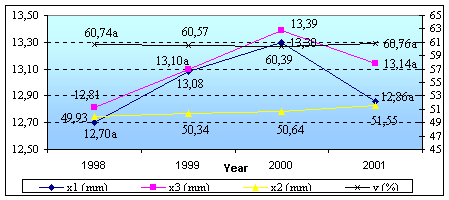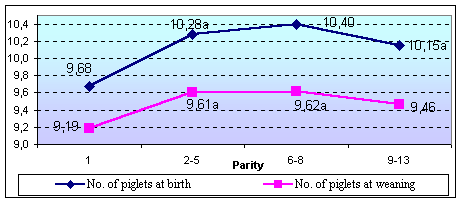Factors Affecting Meat Traits and Fertility of Pigs in Estonia
A. Tänavots, T. Kaart, O. Saveli. Institute of Animal Science, Estonian Agricultural University, Kreutzwaldi 1, Tartu 51014, Estonia
Summary
Local pig breeds have had high fertility during the times. Recently, however, attention has been paid to improve meatiness traits. The aim of this study was to evaluate effect of different factors on meat traits and fertility. Database was collected from 38 farms during 1998...2001. Backfat thickness and loin eye depth were measured in 26,514 pigs with ultrasonic equipment Piglog-105. The following pig breed combinations were under observation: purebred – Estonian Landrace (EL), Estonian Large White (ELW), Hampshire (H), Pietrain (P) and crossbreds – EL♂xELW♀, ELW♂xEL♀, P♂xH♀. The following factors were included in general linear model: breed, sex, advisor, season, year, parity, farm. Purebred P and crossbred P♂xH♀ pigs had significantly higher lean meat percentage (62.59% and 61.69%), compared with other breeds. Purebred H meat traits were almost at the same level as in local breeds. From local breeds EL breed with lean meat percentage 59.93% was considered better. High lean meat percentage (60.74%) was observed in ELW♂xEL♀. ELW breed had high fertility (11.27), which did not increase by crossing with EL♂. P breed had high mortality (1.65) from birth till weaning. Meat traits have not been improved during last years, except loin eye depth. High fertility was in parities 6...8 and lower in 1st. To improve meat traits, P and EL breeds should be used, whereas high mortality rate of P breed must be considered.
Introduction
During the times local pig breeds have had high fertility as a result of selection of breeding animals by fertility. Recently, however, more attention has been paid to improve meatiness traits. Advisors actively estimate live pigs meat traits with ultrasonic equipment Piglog-105 in Estonia and more attention has been paid also to improve slaughter pigs' meat quality by crossbreeding. The aim of this study was to evaluate effect of different factors on meat traits and fertility.
Material and Methods
Dataset was completed in Estonian Animal Recording Centre from pigs database, which was collected from 38 farms during 1998...2001 in Estonia. Six advisors from Estonian Pig Breeding Association measured 26,514 pigs' backfat and diameter of loin eye with ultrasonic equipment Piglog-105. The following traits were recorded: backfat thickness at last (x1) and 11...12th (x3) rib, 7 cm from midline (mm), and diameter of loin eye (x2), 7 cm from midline (mm) (PÕMm RTL, 1998). Lean meat percentage (y) was calculated using the formula (Piglog 105, 1991). Pigs were tested at 65...150 kg live weight, whereas by using regression relationships between the traits being studied and testing weight, the value of traits investigated was corrected to 100 kg testing weight in all animals.
The following pig breed combinations were under observation: purebred – Estonian Landrace (EL), Estonian Large White (ELW), Hampshire (H), Pietrain (P) and crossbreds – EL♂xELW♀, ELW♂xEL♀, P♂xH♀. The following factors were included in general linear model: breed, sex, advisor, season, year, parity, farm. The testing year was divided into four parts: spring - March, April, May; summer - June, July, August, fall - September, October, November and winter - December, January, February.
General Linear Model (GLM) was used to analyse dataset by SAS software (SAS Inst. Inc., 1991).
Yijklmno=μ+Ti+Mj+Kk+Se+Am+Pn+Fo+eijkl,
Y= dependent variable; Se = season (n=1...4);
μ = general mean; Am = year (n=1...4);
Ti = breed (n=1...7); Pn = parity (n=1...13);
Mj = sex (n=1...2); Fo = farm (n=1...4);
Kk = advisor (n=1...6); eijkl = random residual effect
The results are given as least-square means (Parring et al., 1997). Level of significances expressed conventionally: a, b, c – least square, within each effect with one letter in common do not differ significantly.
Results and Discussion
Hampshire and Pietrain are well known for their excellent meatiness traits, but also for their low fertility. Table 1 shows that purebred Pietrain and crossbred P♂xH♀ pigs had thinner backfat, larger diameter of loin eye and higher lean meat percentage, compared to other combinations. On the other hand, Hampshire, meat traits were almost on the same level as those of local breeds. Estonian Large White had a little higher backfat and significantly lower diameter of loin eye (48.35 mm); therefore, lean meat percentage was also significantly lower (59.42%), compared with Estonian Landrace (59.93%). Klimiene et al. (2000) found lean meat percentage between 49.20...51.68 in Lithuanian White in 1996...1998. Crossbreeding between local breeds resulted in slightly lower backfat and significantly higher diameter of loin eye than purebreds.
Significantly higher fertility was found in purebred Estonian Large White pigs and their crosses with Estonian Landrace boar, but on the other hand high fertility caused also high mortality from birth till weaning.
Table 1. Meat traits and fertility traits of pig breed combinations
|
Traits |
EP |
ESV |
H |
P |
EPxESV |
ESVxEP |
PxH |
|
n |
8910 |
14303 |
185 |
87 |
2040 |
966 |
23 |
|
x1 (mm) |
13.83a |
13.92a |
14.18a |
11.29b |
13.38 |
12.90 |
11.41b |
|
x2 (mm) |
49.69a |
48.35 |
50.40ab |
53.55c |
50.26b |
50.22b |
51.82bc |
|
x3 (mm) |
13.70a |
14.18b |
13.88ab |
11.15 |
13.64a |
12.83c |
12.37c |
|
y (%) |
59.93a |
59.42 |
59.80a |
62.59b |
60.13 |
60.74 |
61.69b |
|
No. of piglets at birth |
10.25a |
11.27b |
9.00c |
9.83ad |
11.28b |
10.24a |
9.02cd |
|
No. of piglets at weaning |
9.99a |
10.35b |
8.60c |
8.18c |
10.38b |
10.05a |
8.73c |
|
Difference |
0.26 |
0.92 |
0.4 |
1.65 |
0.90 |
0.19 |
0.29 |
In 1997 the author found (Tänavots, 1997) heterosis effect on fertility in crossing, but in this study, fertility of the purebred pigs was about same level as their crosses. Hampshire and its cross with Pietrain had low fertility, compared with other breeds. Purebred Pietrain had very high mortality from birth till weaning (1.65 piglets).
Difference between sexes showed significantly lower backfat and higher lean meat percentage in male pigs (Table 2).
Table 2. Sex influence on meat traits
|
Traits |
Female |
Male |
|
n |
20462 |
6052 |
|
x1 (mm) |
13.69 |
12.29 |
|
x2 (mm) |
50.65a |
50.58a |
|
x3 (mm) |
13.67 |
12.54 |
|
y (%) |
60.11 |
61.12 |
Testing season showed significantly lower lean meat percentage (60.50%) in autumn and higher (60.74%) in spring (Table 3).
Table 3. Meat traits depending on testing season
|
Traits |
Winter |
Spring |
Summer |
Fall |
|
n= |
6933 |
4800 |
6071 |
8710 |
|
x1 (mm) |
12.93a |
12.90a |
13.11 |
13.02 |
|
x2 (mm) |
50.30 |
50.62a |
50.99 |
50.55a |
|
x3 (mm) |
13.12a |
12.94 |
13.11a |
13.26 |
|
y (%) |
60.59a |
60.74 |
60.62a |
60.50 |
Thus, better periods for fattening are autumn and winter and the worst are spring and summer.
During the years, backfat thickness was not considerably changed (Figure 1).

Figure 1. Trend of meat
traits in 1998...2001
Trend for backfat thickness was increasing from 1998 to 2000, and decreased at the beginning of this year, whereas difference between two measuring points is higher than in other years. Diameter of loin eye was increasing during the years, from 49.93 mm in 1998 to 51.55 mm in 2001, but lean meat percentage is today on the same level as in 1998.
Significantly lower fertility was in first parity, which increased till parities 6...8 and decreased in parities 9...13 to the same level as in parities 2...5 (Figure 2)

Figure 2. Fertility according to different parities
High fertility is related to high fertility, being in 6...8 parities 0.78 piglets and lower in 1st parity (0.49 piglets).
Finally, it should be noted, that the best local breed to produce fattening pigs was Estonian Landrace. Crossing between local breeds improved meat traits slightly, but fertility was on the same level as in purebreds. From imported breeds, Pietrain breed should be preferred to improve meatiness traits because its meat traits were better than in Hampshire breed. Estonian Large White from local breeds and Pietrain from imported breeds had higher fertility, but it should be taken into consideration, that Estonian Large White had high mortality and that of Pietrain was extremely high. Therefore, to select these breeds, farmers should have good conditions to rear piglets. Farmers should also consider, that litter size will increase till 8th parity, after which it will decrease.
References
Klimiene, A., Klimas, R. 2000. Phenotypic evaluation of pig leanness. Book of Abstracts of the 51st Annual Meeting of the EAAP. The Hague, The Netherlands, 21-24 August. p. 323
Parring, A-M., Vähi, M., Käärik, E. 1997. Statistilise andmetöötluse algõpetus. TÜ Mat. stat. inst. TÜ Kirjastus. p. 183...254.
Piglog 105. 1991. Piglog 105 User’s Guide. Soborg, Denmark: SFK - Technology, 14 pp
PÕMm RTL. 1998. Põllumajandusministri 15. veebruari 1996. a määruse nr 5 «Tõuaretuseeskirjade kinnitamine» ja 8. märtsi 1996. a määruse nr 8 «Tõuaretusühingule tegevusloa andmise eeskirja kinnitamine» muutmine, 321-324, 1327
SAS. 1991. SAS User’s guide: Statistics. SAS Inst. Inc., GARY, NC. 305 pp.
Tänavots, A. 1997. Suurt valget tõugu emiste viljakus ja piimakus. Magistritöö. Tartu 90 lk.